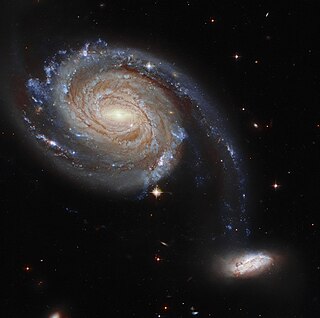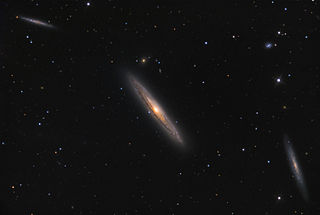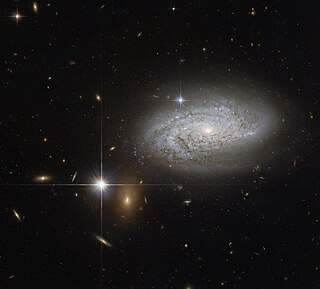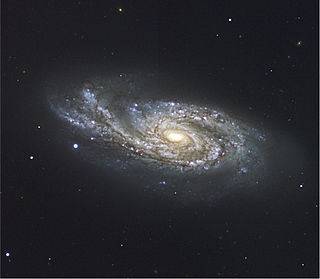
Messier 100 is a grand design intermediate spiral galaxy in the southern part of the mildly northern Coma Berenices. It is one of the brightest and largest galaxies in the Virgo Cluster and is approximately 55 million light-years from our galaxy, its diameter being 107,000 light years, and being about 60% as large. It was discovered by Pierre Méchain in 1781 and 29 days later seen again and entered by Charles Messier in his catalogue "of nebulae and star clusters". It was one of the first spiral galaxies to be discovered, and was listed as one of fourteen spiral nebulae by Lord William Parsons of Rosse in 1850. NGC 4323 and NGC 4328 are satellite galaxies of M100; the former is connected with it by a bridge of luminous matter.

NGC 3184, the Little Pinwheel Galaxy, is a spiral galaxy approximately 40 million light-years away in the constellation Ursa Major. Its name comes from its resemblance to the Pinwheel Galaxy. It has two HII regions named NGC 3180 and NGC 3181.

NGC 1532, also known as Haley's Coronet, is an edge-on barred spiral galaxy located approximately 50 million light-years from the Solar System in the constellation Eridanus. The galaxy was discovered by James Dunlop on 29 October 1826.

NGC 7752 and NGC 7753 are a pair of galaxies approximately 272 million light-years away in the constellation Pegasus.

NGC 4216 is a metal-rich intermediate spiral galaxy located not far from the center of the Virgo Cluster of galaxies, roughly 55 million light-years away. It is seen nearly edge-on.

NGC 1309 is a spiral galaxy located approximately 120 million light-years away, appearing in the constellation Eridanus. It is about 75,000 light-years across, and is about 3/4s the width of the Milky Way. Its shape is classified as SA(s)bc, meaning that it has moderately wound spiral arms and no ring. Bright blue areas of star formation can be seen in the spiral arms, while the yellowish central nucleus contains older-population stars. NGC 1309 is one of over 200 members of the Eridanus Group of galaxies.

Arp 271 is a pair of similarly sized interacting spiral galaxies, NGC 5426 and NGC 5427, in the constellation of Virgo. It is not certain whether the galaxies are going to eventually collide or not. They will continue interacting for tens of millions of years, creating new stars as a result of the mutual gravitational attraction between the galaxies, a pull seen in the bridge of stars already connecting the two. Located about 130 million light-years away, the Arp 271 pair is about 130,000 light-years across. It was originally discovered in 1785 by William Herschel. It is speculated, that the Milky Way will undergo a similar collision in about five billion years with the neighbouring Andromeda Galaxy, which is currently located about 2.6 million light-years away.

NGC 4651 is a spiral galaxy located in the constellation of Coma Berenices that can be seen with amateur telescopes, at a distance not well determined that ranges from 35 million light years to 72 million light years.

NGC 4527 is a spiral galaxy in the constellation Virgo. It is a member of the M61 Group of galaxies, which is a member of the Virgo II Groups, a series of galaxies and galaxy clusters strung out from the southern edge of the Virgo Supercluster.

NGC 3021 is a spiral galaxy in the northern constellation of Leo Minor. It is about 93 million light-years away from Earth, and is receding with a heliocentric radial velocity of 1,537±4 km/s. This galaxy was discovered December 7, 1785 by Anglo-German astronomer William Herschel. The morphological classification of NGC 3021 is SA(rs)bc, which indicates a spiral galaxy with no central bar (SA), an incomplete inner ring structure (rs), and moderate to loosely wound spiral arms (bc).

NGC 6181 is a barred spiral galaxy located in the constellation Hercules. It is designated as SB(rs)c in the galaxy morphological classification scheme and was discovered by William Herschel on 28 April 1788. The galaxy is 107 million light years away.

NGC 2857 is a spiral galaxy in the constellation Ursa Major. It was discovered on January 9, 1856, by R. J. Mitchell.

NGC 6373 is a barred spiral galaxy located in the constellation Draco. It is designated as SBc in the galaxy morphological classification scheme and was discovered by the American astronomer Lewis A. Swift on 13 June 1885. There are two recorded supernovae in this galaxy designated SN 2001ad and SN 2012an.

NGC 936 is a barred lenticular galaxy in the constellation Cetus. It is at a distance of about 60 million light-years away from Earth. Its nucleus and prominent bar have high surface brightness. Because of the shape of the prominent bar, the nucleus and the ring of stars at the end of the barrel, the galaxy has been compared with the shape of a TIE fighter, from the Star Wars universe, and thus NGC 936 has been named Darth Vader’s Galaxy or Darth Vader’s Starfighter. By measuring the radial velocity of the disc, Kormendy found in 1986 that the disc is stable, which is the reason why it is so smooth.

NGC 908 is an unbarred spiral galaxy in the constellation Cetus. It was discovered in 1786 by William Herschel. This galaxy is 56 million light years away from Earth. It is the main galaxy in the NGC 908 group, which also includes NGC 899, NGC 907, and IC 223.

NGC 5861 is an intermediate spiral galaxy in constellation Libra. It is located at a distance of about 85 million light years from Earth, which, given its apparent dimensions, means that NGC 5861 is about 80,000 light years across.

NGC 4076 is a spiral galaxy located 290 million light-years away in the constellation Coma Berenices. The galaxy was discovered by astronomer William Herschel on April 27, 1785 and is a member of the NGC 4065 Group.

NGC 4090 is a spiral galaxy located 340 million light-years away in the constellation Coma Berenices. The galaxy was discovered by astronomer Heinrich d'Arrest on May 2, 1864 and is a member of the NGC 4065 Group.

NGC 941 is an intermediate spiral galaxy in the constellation Cetus. It is an estimated 16.83 MPc from the Milky Way and has a diameter of approximately 55,000 light years. The galaxies NGC 926, NGC 934, NGC 936, NGC 955 are located in the same sky area. NGC 941 was discovered by the astronomer William Herschel on 6 January 1785.

NGC 807 is an elliptical galaxy located in the constellation Triangulum. It is listed as part of the New General Catalogue (NGC) of astronomical objects. It was discovered by the astronomer William Herschel on September 11, 1784.





















